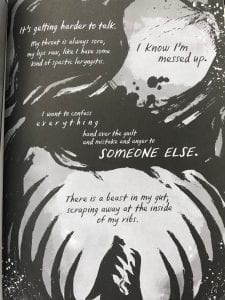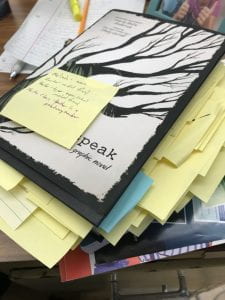How do we get our students to read? How do we create a culture of reading? How do we increase empathy and human connection in an increasingly disconnected world? Project Lit has proven to do exactly this and more. This is a world-wide movement begun by Jarred Amato (@jarredamato) and I am eternally grateful. As a social studies teacher, I fully understand the power of books and why we need to talk about them with our students. I know full well why books and intellectuals are the first targets by those who seek to control a population…
My students and I founded a Project Lit chapter in our high school and I could not be more excited. My first experience with Project Lit was in my daughter’s middle school, founded by the inspiring Sarah Levy (@teachreadrepeat). My daughter loves to read, and as she grows into a young teen, we don’t always have the greatest things to connect with – but literature will always be a shared love. We were invited to attend these monthly meetings held during the early evening with teachers, administrators, parents, and students at her middle school. We ate together, laughed together, shared literature together, and found our young students/children deserving of so much credit for their mature insights into the world around them. Project Lit gives us a chance to talk about the world around us as these shared books focus on representation in characters and authors. I am now thrilled that my son has now joined the club and I get to spend time at home reading the same books with my kids.
This is also a good time to point out another wonderful aspect of this club – my Language Arts colleague, Paul G., volunteered to help me charter this club and we are partners in this endeavor! Too often, there are few chances to collaborate across disciplines in a high school setting (I teach social studies), so this is just awesome!
This year, my students voted to have the graphic novel adaptation of Laurie Halse Anderson’s Speak (hauntingly illustrated by Emily Carroll) as the book to read for our first selection. (Our next books to read, as voted by the students – Look Both Ways by Jason Reynolds, Hey, Kiddo by Jarrett Krosoczka, The 57 Bus by Dashka Slater, and Pride by Ibi Zoboi). I have read and reread Speak so many times and continue to learn more each time I do so. The illustrations add so many layers to an already deeply meaningful story. Here are the resources that I have put together so far – feel free to use, share, etc. I am BRAND NEW at this, so please keep that in mind.
PowerPoint – https://drive.google.com/open?id=19gGSk7HT5bSB6Md63urMsP8rUSnV-hO
Handout – this is a general plan of discussing the book over two meetings of 45 minutes each, – https://drive.google.com/open?id=1GwJdlUdp6-qy-5vAZjyvVSdKVmOy8t-I
Handout Part II – https://drive.google.com/open?id=1OcXnPmuGN1wIU26pvarVQ8a_H7eueLMm – these are some FAQs directly from Laurie Halse Anderson’s website.
Teacher Guide from Macmillan – https://images.macmillan.com/folio-assets/teachers-guides/9780374300289TG.pdf – created by my wife and I.
One concern I have going into this initial meeting is that I don’t want it to be run/dominated by the adults. I don’t want me to do much talking at all and to do more listening. I will certainly add my voice to the discussions, but as an equal participant. I did not put my examples or answers in the PowerPoint as the students would not be able to do so. Instead, we will all be pointing out panels/pages in our books as we discuss. Of course, this just means that my book is full of sticky notes!
Meeting Two –
Oops! I did exactly what I feared during the first meeting – I, and other adults, talked too much! We shared our views and our interpretations, especially when the conversation died out a bit. The adults needed to give better wait time and allow students to lead the conversation. On day 2, I would consider this task accomplished! The students were absolutely amazing, created their own questions, and even felt free to disagree with the adults. We were able to have a cross-generational discussion and learned from one another – as equals. I think part of this was due to first meeting nerves on the first day meeting. We even had new students join in the club – some had not even read the book. However, students were quickly pointing out parts of the book and the non-readers jumped into the larger social conversation. I’m going to do my best to jot down just some of the topics we discussed today –
*How to help a friend/student/fellow human showing signs of depression and self harm
*How we all feel alone and need to do a better job of looking outside our worlds. Parents need to SEE their kids.
*Older generation tended to be more “suck it up” – this is not appropriate for today
*Development of the teen brain and prefrontal cortex (the students brought this up!)
*Judge Kavanaugh hearings – what does this mean for those who have been sexually assaulted and coming forward?
*#MeToo
*How the ideas of “boys will be boys” is outdated and as insulting to males as it is to females. We all agreed that this book is just as important for boys to read as it is for girls. I was honestly a bit surprised at how non awkward the conversation was – that we were all open to talking about the topic of rape.
*Gender stereotypes – the idea of “manning up” and being macho has changed. The lines are blurred are we need to be who we are. Many in the “older” generation have not yet realized this change.
*Rape is rape. End of story. It doesn’t matter how the girl dresses, or acts, or what she drinks. We need to make the conversation about the rapists, not the victims. If we only teach our girls the “proper” way of dressing, acting, etc. to not be a victim, what we are really doing is just making sure that our daughter is not a victim, but it does nothing to save others. You have to change the behavior of males and rape culture.
*We are all going through something – even Heather. Don’t be dismissive of what people are going through. Even Melinda was a bit dismissive – not paying attention to her friend’s struggle with anorexia, etc.
*The illustrations really added feeling to the story – students were very animated in pointing to the panels that stuck out to them the most. How the trees and climate changes had such a deep meaning. Emily Carroll also added a feeling of horror.
*Wonderful conversation about the differences between the prose and graphic novels. Each of us learned more from either version than the other. Those who were not familiar with graphic novels said they learned so much about how the illustrations added so much depth to the story – to slow down when reading graphic literature. I know that I personally did not fully understand the meaning of the trees until I had read the graphic novel adaptation.
*More and more voices are being heard today. It’s not that there are suddenly more rape victims, more depressed people, more trans people, etc. – it’s just that we are now finally hearing their voices and our society is trying to figure it all out.
*Discussion of rape kits that are sitting in warehouses – it’s like being forgotten, not being treated as a human. Why put yourself out there and speak your truth if those in authority are not going to help? Rape trials like being raped again.
*Stereotypes of high school and social hierarchy
*How would the story be different if set in a school today? How would social media play a part?
*When you speak up for yourself, you’re not just helping yourself – it’s about helping other victims.
*Not a happy/satisfying ending – but this is more realistic.
*What would/should be in book 2? What should happen to It? Melinda? Heather? Melinda’s parents?

 *This one particular image came up multiple times in the conversation. How it can mean so much and in many different ways. Only graphic novels can create this type of individual meaning.
*This one particular image came up multiple times in the conversation. How it can mean so much and in many different ways. Only graphic novels can create this type of individual meaning.
-These are just SOME of the topics we tackled over our two meetings, and we could have had many more meetings and still not have talked about everything on our minds. I learned that it’s not about TEACHING the book, but allowing it to lead us to a meaningful conversation about ourselves and our world. I could write even more, but will stop here – I am absolutely just awestruck at the power of Laurie and her story. At the power of Project Lit. At the power of books. I am looking forward to our next meeting as we read and discuss Look Both Ways by Jason Reynolds.
I was also able to talk about my own childhood and the sexual abuse that I had experienced. Over the past few years, I have found it ever more valuable to be more human with my students and to share what makes us us. I related my experience telling Laurie about this and how she responded, “we are family now.” – These topics are not “R” rated and these books should not be banned from schools. Like it or not, these “events” are happening to our kids and they need to know they are not alone. Books like these save lives.
At the end, we also discussed Laurie’s other books – many were fans of “Fever” but did not know that this was the same author! I also loaned out a few copies of Shout (Laurie’s “sequel” to Speak) and the Impossible Knife of Memory – two books that shed so much insight into Speak. I HIGHLY recommend these two books. And this is the most wonderful part – students borrowed books to read, not even to be a member of a club, but because they became genuinely connected to Laurie Halse Anderson on a personal and emotional level. Thank you, Laurie.
During lunch today, I sent the following message to those in the group –
THANK YOU so much for everyone who was able to make Friday and/or today’s meeting(s). The topics we were able to talk about just absolutely blew my mind and I am so proud of everyone. I really believe that books, like those in Project Lit, can change the world. In a world where we are increasingly distracted by our devices, when we feel alone in a sea of connectedness, I appreciate you. Out of all the choices we have during I/E, to CHOOSE to be a part of a group to read and discuss books, to have the courage to talk about “difficult” topics… I just can’t thank you all enough and I look forward to an amazing year. Please help spread the word. I am so sorry that I forgot to take a picture today!!!!!!!
Next book is Jason Reynold’s Look Both Ways and we will be meeting to discuss on 11/6 and 11/7. All of my books were already borrowed today. When you are finished reading, please bring them back so that others may read them before the next meeting.
THANK YOU!!!!!!

